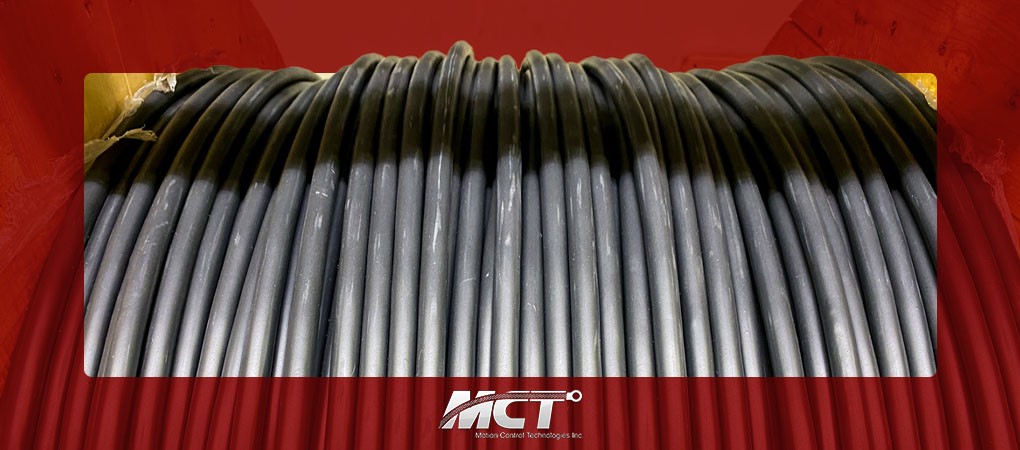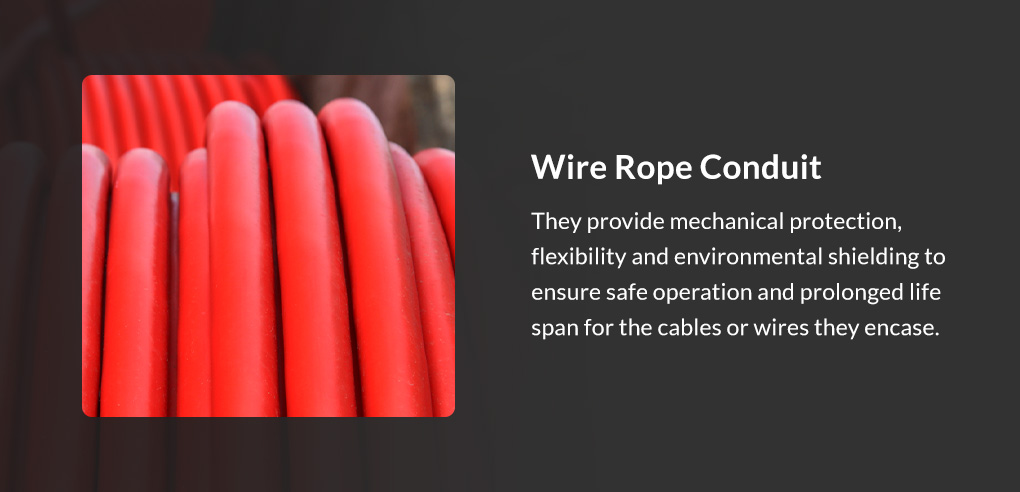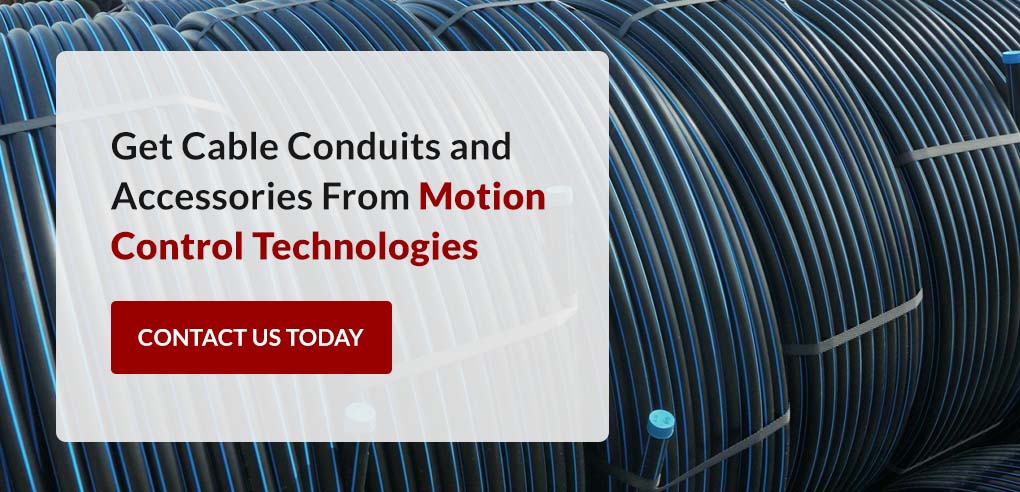
Cable conduits are vital for protecting and organizing cables in industrial systems. These protective enclosures are designed to shield electrical or mechanical cables from environmental exposure, physical damage and operational wear. They come in various types to suit the different uses of cable conduits.
Selecting the right conduit is critical to avoid operational disruptions and extend the cables' life span. By evaluating factors like the environment, flexibility and load requirements, you can invest in a solution that meets your operation's unique needs.
Types of Cable Conduits
These conduits differ in material, flexibility and resistance to environmental factors. In learning how to tell the difference between various conduits, you should examine the material composition, structure and corrosion resistance.
Rigid Conduit
Rigid conduits are critical in electrical and mechanical systems, offering durable pathways for cables, wiring and other utilities. In industries where durability, safety and reliability are non-negotiable, rigid conduits stand out as a robust solution. These tube-like enclosures are made from materials like aluminum, steel or plastic. As the name suggests, they maintain a fixed shape, offering unparalleled structural integrity. Key characteristics include:
- Material strength: These conduits are typically manufactured from aluminum, polyvinyl chloride (PVC), galvanized or stainless steel. This material resists mechanical damage and can withstand high-impact environments.
- Environmental protection: Rigid conduits offer protection against water ingress, corrosion and chemical exposure. This shielding makes them suitable for both indoor and outdoor applications, including harsh industrial environments.
- Fire resistance: Non-combustible metal conduits, like galvanized steel, provide an added layer of fire protection, which is a critical feature for industrial and commercial applications.
- Code compliance: Engineered to meet the National Electrical Code (NEC) standards and local building codes, these conduits ensure safety and reliability.
These characteristics make this tube ideal for use in high-rise buildings and large-scale commercial projects to ensure wiring protection and fire safety. They are also widely used in stairwells and emergency systems. Infrastructure projects use them in bridges and transportation systems to protect wiring from mechanical stress, and data centers use them to protect sensitive data cables and networking equipment.
Flexible Conduit
Flexible conduits are characterized by their ability to bend and adapt to non-linear pathways. They offer a durable solution for routing and protecting wiring in environments where rigidity may pose challenges, such as tight spaces, moving machinery or areas subject to vibration. These conduits are typically constructed from materials like aluminum or galvanized steel, PVC or polyethylene plastics or a combination of both, like liquid-tight flexible metal conduits. Key characteristics include:
- Material flexibility: Flexible conduits can bend around obstacles and corners, making them ideal for applications with irregular layouts or limited space.
- Environmental protection: Many flexible conduits are resistant to moisture, chemical UV radiation and temperature fluctuation, making them suitable for harsh conditions.
- Mechanical strength: Despite their flexibility, they offer significant resistance to crushing, impact and abrasion, especially those conduits made from various metals.
- Connection ease: Flexible conduits are simple to connect with fittings, reducing installation time. They can also come with additional coatings for chemical or corrosion resistance.
These conduits work well in dynamic environments with a lot of machinery and moving parts. They are also often used in areas requiring frequent maintenance or wiring re-routing in the automotive, manufacturing and robotics industries.
PVC Conduit
PVC conduits can be rigid or flexible and made from thermoplastic material. They are non-metallic and lightweight, offering resistance to chemicals and environmental factors. Key characteristics include:
- Electrical insulation: PVC is a natural insulator, eliminating the risk of electrical conductivity and reducing hazards. It provides an added layer of protection for enclosed wiring, especially in high-voltage setups.
- Fire resistance: Many PVC conduits are treated with flame-retardant additives to comply with fire safety standards. In case of fire, the material is designed to self-extinguish, minimizing fire spread.
- Moisture resistance: These conduits are watertight, making them suitable for environments with high humidity or direct exposure to water. Gasket-sealed fittings further enhance their moisture resistance.
- Temperature tolerance: When installed according to specifications, PVC conduits can operate efficiently and maintain their structural integrity in both hot and cold environments.
PVC conduits are versatile and adaptable and can be used in a wide range of commercial, industrial and residential settings. They are ideal for concealed or surface-mounted wiring systems in concrete or drywall. In residential projects, they serve as buried wiring in gardens and driveways, where water or soil exposure is a concern.
Metal Conduit
Metal conduits are essential for safeguarding electrical installations from physical damage, corrosion and interference while providing an organized pathway for electrical conductors. They are typically made from materials like aluminum and steel and are integral to creating durable and code-compliant electrical systems. Key characteristics include:
- Types of metal conduits: They are available in rigid metal, intermediate metal, electrical metallic tubing, flexible metal and liquid-tight flexible metal materials.
- EMI shielding: Metal conduits reduce electromagnetic interference (EMI), protecting sensitive equipment and ensuring signal integrity in industrial settings.
- Material durability: These conduits are made from aluminum, galvanized steel or stainless steel, providing excellent resistance to physical impact, wear and environmental factors like chemicals and moisture.
- Customizable features: Available in various lengths and diameters, metal conduits can be easily tailored to specific project requirements. Accessories like connectors, couplings and fittings enhance their versatility.
Heavy-duty environments like manufacturing plants, refineries and chemical facilities benefit from the robust protection against physical damage and corrosive substances provided by metal conduits. Rigid and intermediate metal conduits in environments with combustible dust and chemical gases meet stringent safety standards to prevent electrical sparks and ensure reliability.

Wire Rope Conduit
Wire rope conduits, also known as cable conduits, are specifically designed to encase wire ropes, cables or similar linear components in industrial settings. They provide mechanical protection, flexibility and environmental shielding to ensure safe operation and prolonged life span for the cables or wires they encase. Key characteristics include:
- Durable construction: Made from materials like reinforced polymers, aluminum and stainless steel, these conduits resist wear, physical damage and corrosion. They are often treated with coatings or finishes to enhance resistance to UV, moisture and chemicals.
- Load bearing capacity: Engineered to handle specific weight and tension loads without compromising the enclosed wire rope.
- Safety features: Wire rope conduits minimize the risk of accidents by preventing contact between the moving wire rope and nearby equipment or personnel. It reduces the potential for fraying, snapping or tangling.
- Sizes and variability: They are offered in various diameters and lengths to accommodate different wire rope dimensions and operational requirements.
Wire rope conduits protect lifting cables in industrial cranes, ensuring reliable performance under heavy loads. They are also used in:
- Elevators
- Vertical transport systems
- Marine and offshore applications
- Mining and drilling
- Utility and energy sectors
- Architectural and structural engineering systems
How to Choose the Right Conduit
Selecting the appropriate cable conduit requires a clear understanding of the application and environment. Consider factors like environmental conditions, moisture or temperature exposure, flexibility needs and load requirements. Choose conduits with high corrosion resistance for harsh environments, like stainless steel or liquid-tight models. For dynamic systems, flexible conduits are ideal.
It is also essential to evaluate the conduit size to ensure proper cable fit while allowing room for installation and maintenance. Properly assessing these criteria helps ensure a reliable, cost-effective solution that safeguards cable systems and maximizes operational efficiency.
Get Cable Conduits and Accessories From Motion Control Technologies
Various types of cable conduits are available, each tailored to specific conditions, and provide durability, safety and efficiency across applications. Ultimately, cable conduits contribute to streamlined operations, reduce maintenance costs and ensure compliance with safety standards, making them an essential component in modern industrial infrastructure.
Since 1998, Motion Control Technologies has crafted industrial cable, rope and tools for applications that include automotive, electronic, trucking and medical industries. We engineer and produce custom products for our clients, following all the required regulations and unique specifications. We cater to short-runs, custom solutions and high-volume production needs.
Contact us today for help with your conduit needs, or request a quote for your project.



You must be logged in to post a comment.